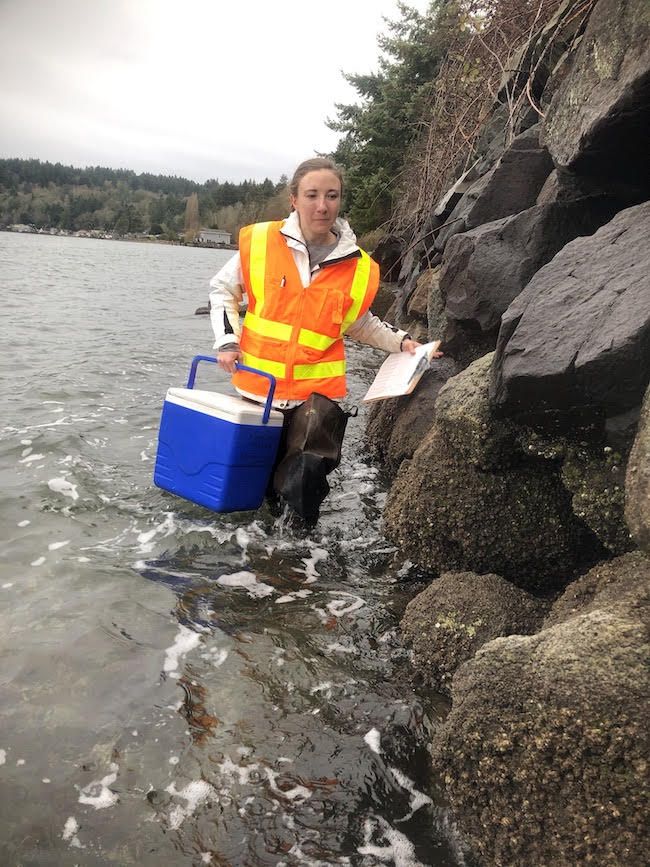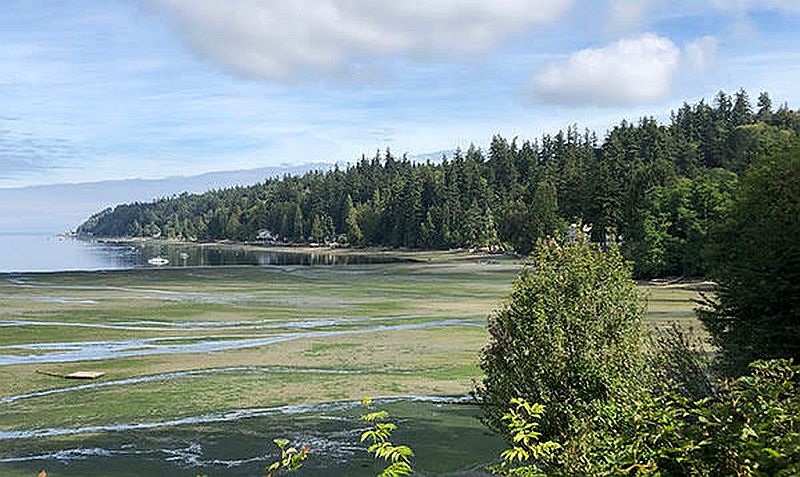Written by: Mary Bruno, Vashon-Maury Island Groundwater Protection Committee Member.
This is the first in a quarterly series of guest blog posts that Mary will be sharing about water quality topics that the Groundwater Protection Committee is working on on the islands.
Teams of yellow-vested, cooler-toting strangers will be poking around the beaches of North Colvos Passage this fall. Fear not. They’re with King County Stormwater Services, and they’re trying to keep poop out of Puget Sound. Stormwater crews will be sampling the various freshwater drainages along the waterfront as part of King County’s Healthy Beach Project, a 12-year-old effort by Public Health—Seattle & King County (PHSKC), the King County Department of Natural Resources and Parks (DNRP) and the State Department of Health (DOH). The goal of the “sanitary surveys” is to find and fix current sources of fecal pollution and prevent future problems.

The North Colvos Passage Healthy Beach Project runs through September 2022. The study area extends from Baldwin Creek (in Fern Cove) north around the tip of Vashon to the ferry terminal. There are about 150 homes along that west- and north-facing stretch of shoreline. Project leaders hope that at least two-thirds of those homeowners will participate in the survey. That sample size would provide a solid overview of the study area, according to PHSKC project supervisor Meagan Jackson. “We have a small amount of information about pollution sources now,” she says. “Part of our goal is to try to figure out how serious the septic issues are.” [Full disclosure: I live just south of the study area.]
The North Colvos project unfolds in three phases. Phase One, which began this month, is all about outreach and information gathering. In this age of COVID, County health personnel will notify homeowners about the project by mail, then make themselves available by phone, email and in virtual Q&A sessions to explain goals and methods, talk to homeowners about their properties and septic systems, and (hopefully) secure permission to sample along their beachfronts.
Phase Two of the Healthy Beach Project focuses on solutions and prevention. Fecal pollution from pet waste and underperforming septic systems threatens the health of our shorelines and all the cool stuff we like to do along them, from beachcombing to shellfish harvesting. (Pet and septic waste can threaten drinking water too.) Shoreline homeowners can easily reduce fecal pollution by picking up after pets and securing their garbage to keep wildlife from congregating. But septic problems are trickier. Part of the Phase Two goal, says Jackson, is to help homeowners care for their septic systems so that they avoid the “really serious septic issues that can cause a lot of pollution and are very expensive to fix.”
The North Colvos Passage study is Vashon’s second Healthy Beach Project. The first survey, which ran from Spring 2018 to Spring 2020, targeted 400 shoreline properties in Outer Quartermaster Harbor, Dockton, Neill Point, Dolphin Point, Summerhurst, Klahanie, Hawthorne and Glen Acres. All but two of those neighborhoods—Dockton and Neill Point—had received Marine Recovery Area designations under the 2008 state law that requires counties bordering Puget Sound to red flag shorelines where bacterial pollution has shut down shellfish harvesting. North Colvos is not a Marine Recovery Area. It was chosen for the new study, in part, to keep it from becoming one. Local residents have been registering concerns about “smells or suspicious water running out onto the beach from pipes on the properties,” says Jackson. The State DOH already prohibits shellfish harvesting along the entire west-facing shoreline of the study area.
If the North Colvos project does uncover any serious septic failures, fixing them will be a challenge on two fronts. The first challenge is technical. Sandwiched between the shoreline and steep banks, many North Colvos homes have little space for new septic. Community drain fields offer one potential solution; there are several on the Island. Drip line septic technology is another. Similar to drip irrigation, this relatively new drain field design uses smaller more flexible tubing which takes up less space and can conform more easily to existing property footprints. “We’re definitely open to other options,” says Jackson. PHSKC has already requested waivers from DOH that would allow for “more creative” approaches.
Septic solutions are rarely cheap. A full-on replacement can run upwards of $20,000. Even smaller repairs and maintenance can pinch a household budget. Which is why cost is the second challenge for the North Colvos project. PHSKC and its partners, which include Craft3, King County Housing Repair, and Habitat for Humanity, currently offer financial assistance in the form of rebates for septic inspections and low-interest loans for upgrades and replacements. Jackson and her team plan to make those existing programs easier to find and apply for—and to develop new ones.
Phase Three of the North Colvos Healthy Beach Project is the fix-it phase. PHSKC won’t require homeowners to correct failing septics until it has a firm handle on the scope of the problem and the most effective solutions. But eliminating the sources of fecal pollution, says Jackson, “will be one of the outcomes at some point.”
North Colvos community members will get to weigh in on all aspects of the Island’s second Healthy Beach Project. One takeaway from the 2018-2020 survey was the value of community input. The Vashon-Maury Island Advisory Group, created during the 2018-2020 project, includes reps from DOH, the Puyallup Tribe and half a dozen local residents. The group still meets quarterly. “They provided such amazing feedback and insight,” says Jackson, who is currently recruiting new Advisory Group members from the new North Colvos study area.
Fecal pollution doesn’t get fixed overnight. It’s a long-term, step-by-step process, says Jackson. The pandemic might make long-term even longer. But if the end result is healthy shorelines by way of innovative, community-driven, low-cost septic solutions, it’ll be worth the wait.
Header image: The North Colvos Healthy Beach study area extends from Baldwin Creek (in Fern Cove) north to the ferry terminal. Photo by Mary Bruno


This is great to know about! Thanks for the interesting and informative overview, Mary. Have you shared this with the Beachcomber? Seems they would be interested.